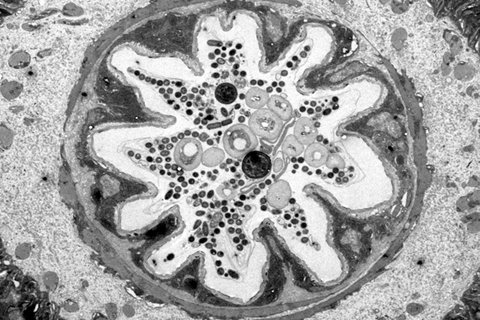The digestive tract of fruit flies remodels itself to accommodate beneficial microbiome species and maintain long-term stability of the gut environment, according to new research led by Carnegie Science’s William Ludington and Allan Spradling.

Their findings are published in Nature Communications.
“Every day, we encounter, and even ingest, a diverse array of bacterial species,” explained Ludington, who has been probing microbiome acquisition and composition for several years at Carnegie. “Despite this, the gut microbiome remains relatively stable over time—a phenomenon that is maintained across many species ranging from mammals to insects.”
He, Spradling, and their collaborators wanted to determine how our guts can maintain such remarkably consistent microbiome compositions. Because the human microbiome is so complex, they studied fruit flies, which are only colonized by a handful of microbial species.
Promoting colonization
Using sophisticated methods and powerful microscopes, the research team—which included Carnegie’s Ren Dodge, Haolong Zhu, Daniel Martinez, Chenhui Wang, Kevin Aumiller—showed that the fruit fly gut creates physical conditions that selectively promote colonization by certain species.
“The fruit fly gut essentially builds a cozy niche that allows a desirable species of primary colonizers to succeed, fostering a mutually beneficial situation for both the insect and the microbe,” explained Spradling, a longstanding global leader in molecular biology who has developed breakthrough techniques in studying fruit fly genetics.
The researchers found that colonization by a beneficial bacterial strain initiates physical changes in the fruit fly gut that increase the number of binding sites available and produces substances that aid attachment, easing the way for a secondary species to move in.
New possibilities
“Because we’ve discovered this niche in the most powerful model organism for understanding the genetic basis of animal development, it opens up a whole new field of possibilities for understanding the mechanisms by which animals select and control their microbiome,” Ludington concluded.
Their team’s research focused on one particular section of the fruit fly gut that’s transformed into an ideal niche for colonization by two microbial species. Looking ahead, they want to use fly genetics to understand the mechanisms of niche construction and maintenance, as well as search for other potential niches in fruit flies and other animals, including humans.
Other co-authors included Eric Jones and David Sivak of Simon Fraser University, Benjamin Obadia of University of California Berkeley, Andrés Aranda-Díaz and Kerwyn Casey Huang of Stanford University, Zhexian Liu of Johns Hopkins University, Marco Voltolini and Eoin L. Brodie of Lawrence Berkeley National Lab, and Jean Carlson of University of California Santa Barbara.







No comments yet